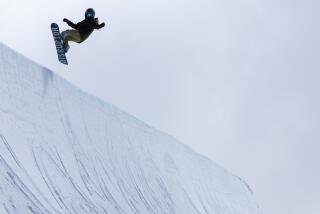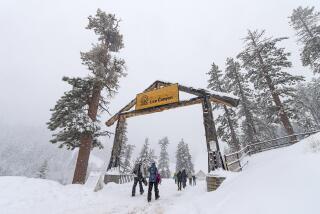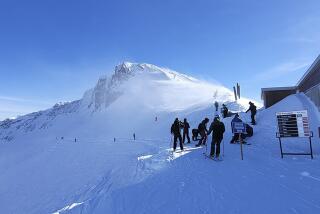How to survive an avalanche? Spit, expert says
Spit could mean the difference between life and death if you are ever caught in an avalanche, an expert says.
Avalanches are rare -- but deadly. Every second is critical to survival, as is keeping calm in the face of calamity. But that’s not easy to do in the face of a terrifying, blinding slide that has the ability to blanket victims in snow and ultimately smother them.
After of a weekend avalanche that claimed the lives of three skiers in Washington state, we asked John Snook, avalanche forecaster for the Colorado Avalanche Information Center, what you should do if you find yourself facing one.
At the first sign of an avalanche, he suggests thrashing around as if your life depends upon it -- because it does. Thrashing, or “swimming,” can help you stay atop the slide and the snow, making survival more likely, he said Monday.
If you are being enveloped by snow, do your best to keep one arm straight above your head. This serves two purposes. It can help you figure out up from down, which is not always possible if you’ve been tossed around and become disoriented, Snook told The Times.
And, if you’re lucky, your gloved hand could be sticking up above the snow to help rescuers find you.
With your other hand, Snook said, try your best to create an air pocket in front of your face before the snow becomes too compacted. People buried in avalanches smother, so an air pocket could provide you with enough air to survive until help arrives, he said.
An air pocket can also make room for this trick: If you’re stuck in the snow and you can’t tell up from down, spit. Gravity will tell you which direction to move -- assuming that you can move.
The best way to avoid an avalanche is to take precautions from the get-go. “Every mountain in the West has a local avalanche center,” he said. Every snow adventurer should be versed in the weather forecast, the snowpack conditions and the avalanche danger rating before venturing out for the day.
Consult the forecast, research the area that you’re planning to traverse and, most important, don’t allow skiers’ “powder fever” to overrule your better judgment, he said.
When traveling in avalanche-prone areas, don’t move together as a pack. Each skier or snowboarder should navigate the stretch ahead alone. That way, if disaster strikes, survivors can alert rescuers to the victim’s whereabouts.
Everyone trekking into the snowy wilderness -- snowboarders, skiers, snowmobilers -- should be carrying an avalanche survival kit containing a snow shovel, a beacon that is worn on the body, and a probe. High-tech probes work hand-in-hand with the beacon to locate a victim and can even poke air holes in the snow to help victims breathe until they can be rescued.
“The whole idea is to just buy yourself some time until help can arrive,” he said.
A relatively new device, a flotation air bag, can be deployed in the case of an avalanche. It’s being credited with saving the life of one of the skiers, Elyse Staugstad, who was also caught in Sunday’s deadly slide.
Snook said he is a fan of the flotation air bag. But, he said, “We fear it will give people a false sense of security.”
Snook also suggests that adventurers understand the basics of avalanches, and use such information for their safety. For example, avalanches cannot occur on slopes that are less than 25 to 30 degrees. When plotting out routes, such knowledge can add an extra cushion of safety so that outdoors lovers can focus on safely getting to their destination instead of courting danger along the way.
Also, adventurers should know this counterintuitive fact: Less snow often means greater danger.
Colorado, for example, has experienced a low-snow year. Those early layers of snow can make for a weak foundation. Ideally, the next layers of snow create heavier “slabs” that make for a solid layer. But if snow is light, the region can be more prone to slabs slipping and sliding and cracking above the poor foundation.
“It’s like trying to build a house with a deck of cards. Eventually that weak foundation fails,” Snook said. “It’s been particularly hazardous this year in Colorado. Probably the most dangerous snowpack we’ve had in 30 years.”
Typically, the people killed in avalanches are skiers or snowboarders. But snowmobilers are catching up, he said, because the machines are more powerful and durable than ever, enabling riders to go farther into the backwoods and higher on slopes.
Snook said Sunday’s avalanche especially hit home with him. He lost a friend to an avalanche last Thursday near Gibbs Creek and Wolf Creek Pass in Colorado. “I’m trying to honor my friend by hopefully helping others,” he said.
So far, 17 people have died in avalanches this snow season. Last year, 36 people died in avalanches, according to the Colorado Avalanche information Center.
ALSO:
Presidents Day reality check: Abraham Lincoln was robbed
Whitney Houston: Town ignored order to fly flags at half-staff
Arizona sheriff outed as gay vows to stay in congressional race
Join Rene Lynch on Google+, Facebook or Twitter
More to Read
Sign up for Essential California
The most important California stories and recommendations in your inbox every morning.
You may occasionally receive promotional content from the Los Angeles Times.











